The Multivariable Alexander Polynomial: Difference between revisions
| (19 intermediate revisions by 8 users not shown) | |||
| Line 9: | Line 9: | ||
n1 = 2 | |
n1 = 2 | |
||
in = <nowiki>MultivariableAlexander</nowiki> | |
in = <nowiki>MultivariableAlexander</nowiki> | |
||
out= <nowiki>MultivariableAlexander[L][t] returns the multivariable Alexander polynomial |
out= <nowiki>MultivariableAlexander[L][t] returns the multivariable Alexander polynomial |
||
of a link L as a function of the variable t[1], t[2], ..., t[c], where c |
|||
| ⚫ | |||
is the number of components of L. MultivariableAlexander[L, Program -> prog][t] |
|||
uses the program prog to perform the computation. The currently available |
|||
programs are "MVA1", written by Dan Carney in Toronto in the summer of 2005, |
|||
and the faster "MVA2" (default), written by Jana Archibald in Toronto in 2008-9.</nowiki> | |
|||
about= <nowiki>The multivariable Alexander program "MVA1" was |
|||
| ⚫ | |||
was written by Jana Archibald in Toronto in 2008-9.</nowiki>}} |
|||
<!--END--> |
<!--END--> |
||
| Line 26: | Line 33: | ||
t[1] -> t1, t[2] -> t2, t[3] -> t4, t[4] -> t3 |
t[1] -> t1, t[2] -> t2, t[3] -> t4, t[4] -> t3 |
||
}</nowiki> | |
}</nowiki> | |
||
out= <nowiki>-t1 - t2 + t1 t2 - t3 + 2 t1 t3 + t2 t3 - t1 t2 t3 - t4 + t1 t4 + |
out= <nowiki>(-t1 - t2 + t1 t2 - t3 + 2 t1 t3 + t2 t3 - t1 t2 t3 - t4 + t1 t4 + |
||
2 t2 t4 - t1 t2 t4 + t3 t4 - t1 t3 t4 - t2 t3 t4 |
2 t2 t4 - t1 t2 t4 + t3 t4 - t1 t3 t4 - t2 t3 t4) / |
||
(Sqrt[t1] Sqrt[t2] Sqrt[t3] Sqrt[t4])</nowiki>}} |
|||
<!--END--> |
<!--END--> |
||
| Line 39: | Line 48: | ||
<!--END--> |
<!--END--> |
||
<!--$$mva - (mva /. {t1->t2, t2->t1})$$--> |
<!--$$Simplify[mva - (mva /. {t1->t2, t2->t1})]$$--> |
||
<!--Robot Land, no human edits to "END"--> |
<!--Robot Land, no human edits to "END"--> |
||
{{InOut| |
{{InOut| |
||
n = 5 | |
n = 5 | |
||
in = <nowiki>mva - (mva /. {t1->t2, t2->t1})</nowiki> | |
in = <nowiki>Simplify[mva - (mva /. {t1->t2, t2->t1})]</nowiki> | |
||
out= <nowiki> |
out= <nowiki> (t1 - t2) (t3 - t4) |
||
----------------------------------- |
|||
Sqrt[t1] Sqrt[t2] Sqrt[t3] Sqrt[t4]</nowiki>}} |
|||
<!--END--> |
<!--END--> |
||
But notice the funny labelling of the components! |
But notice the funny labelling of the components! The program <code>MultivariableAlexander</code> orders the variables in its output (typically denoted <code>t[i]</code>) in the same order as the order of the components of a link <code>L</code> as they appear within <code>Skeleton[L]</code>. Hence we had to rename <code>t[3]</code> to be <code>t4</code> and <code>t[4]</code> to be <code>t3</code>. |
||
(To be precise, <code>MultivariableAlexander</code> orders the components so that its output would be lexicographically minimal among all possible orderings. This way it is at least guaranteed that different presentations for the same link will yield the same output for <code>MultivariableAlexander</code>.) |
|||
====Links with Vanishing Multivariable Alexander Polynomial==== |
====Links with Vanishing Multivariable Alexander Polynomial==== |
||
| Line 98: | Line 107: | ||
X[19, 4, 20, 5], X[21, 7, 22, 6] |
X[19, 4, 20, 5], X[21, 7, 22, 6] |
||
]][t]</nowiki> | |
]][t]</nowiki> | |
||
out= <nowiki> |
out= <nowiki> 2 |
||
-1 + |
-(((-1 + t[1]) (-1 + t[2]) (1 - 2 t[1] + t[1] - 2 t[2] + 2 t[1] t[2] - |
||
2 2 2 2 2 |
|||
2 t[1] t[2] + t[2] - 2 t[1] t[2] + t[1] t[2] )) / |
|||
3 |
3/2 3/2 |
||
(t[1] t[2] ))</nowiki>}} |
|||
<!--END--> |
<!--END--> |
||
We don't know whether our mystery link appears in the link table as is, or as a mirror, or with its two components switched. Hence we let <code>AllPossibilities</code> contain the multivariable Alexander polynomials of all those possibilities: |
|||
| ⚫ | |||
<!--$$AllPossibilities = Union[Flatten[ |
|||
{mva, -mva} /. {{}, {t[1] -> t[2], t[2] -> t[1]}} |
|||
]]$$--> |
|||
<!--Robot Land, no human edits to "END"--> |
<!--Robot Land, no human edits to "END"--> |
||
{{InOut| |
{{InOut| |
||
n = 8 | |
n = 8 | |
||
in = <nowiki>AllPossibilities = Union[Flatten[ |
|||
in = <nowiki>Select[AllLinks[], (MultivariableAlexander[#][t] == mva) &]</nowiki> | |
|||
{mva, -mva} /. {{}, {t[1] -> t[2], t[2] -> t[1]}} |
|||
]]</nowiki> | |
|||
out= <nowiki> 2 |
|||
{-(((-1 + t[1]) (-1 + t[2]) (1 - 2 t[1] + t[1] - 2 t[2] + |
|||
2 2 2 2 2 |
|||
2 t[1] t[2] - 2 t[1] t[2] + t[2] - 2 t[1] t[2] + t[1] t[2] |
|||
3/2 3/2 |
|||
)) / (t[1] t[2] )), |
|||
2 |
|||
((-1 + t[1]) (-1 + t[2]) (1 - 2 t[1] + t[1] - 2 t[2] + 2 t[1] t[2] - |
|||
2 2 2 2 2 |
|||
2 t[1] t[2] + t[2] - 2 t[1] t[2] + t[1] t[2] )) / |
|||
3/2 3/2 |
|||
(t[1] t[2] )}</nowiki>}} |
|||
<!--END--> |
|||
Finally, let us locate our link in the link table: |
|||
<!--$$Select[ |
|||
AllLinks[], |
|||
| ⚫ | |||
]$$--> |
|||
<!--Robot Land, no human edits to "END"--> |
|||
{{InOut| |
|||
n = 9 | |
|||
in = <nowiki>Select[ |
|||
AllLinks[], |
|||
MemberQ[AllPossibilities, MultivariableAlexander[#][t]] & |
|||
]</nowiki> | |
|||
out= <nowiki>{Link[11, Alternating, 289]}</nowiki>}} |
out= <nowiki>{Link[11, Alternating, 289]}</nowiki>}} |
||
<!--END--> |
<!--END--> |
||
| Line 121: | Line 168: | ||
<!--Robot Land, no human edits to "END"--> |
<!--Robot Land, no human edits to "END"--> |
||
{{InOut| |
{{InOut| |
||
n = |
n = 10 | |
||
in = <nowiki>{Jones[L][q], Jones[Link[11, Alternating, 289]][q]}</nowiki> | |
in = <nowiki>{Jones[L][q], Jones[Link[11, Alternating, 289]][q]}</nowiki> | |
||
out= <nowiki> -(17/2) 4 8 12 16 18 17 15 |
out= <nowiki> -(17/2) 4 8 12 16 18 17 15 |
||
Latest revision as of 19:56, 29 August 2013
(For In[1] see Setup)
|
| ||||||||
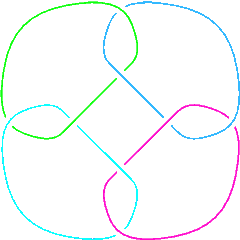 L8a21 |
The link L8a21 is symmetric under cyclic permutations of its components but not under interchanging two adjacent components. It is amusing to see how this is reflected in its multivariable Alexander polynomial:
In[3]:=
|
mva = MultivariableAlexander[Link[8, Alternating, 21]][t] /. {
t[1] -> t1, t[2] -> t2, t[3] -> t4, t[4] -> t3
}
|
Out[3]=
|
(-t1 - t2 + t1 t2 - t3 + 2 t1 t3 + t2 t3 - t1 t2 t3 - t4 + t1 t4 +
2 t2 t4 - t1 t2 t4 + t3 t4 - t1 t3 t4 - t2 t3 t4) /
(Sqrt[t1] Sqrt[t2] Sqrt[t3] Sqrt[t4])
|
In[4]:=
|
mva - (mva /. {t1->t2, t2->t3, t3->t4, t4->t1})
|
Out[4]=
|
0
|
In[5]:=
|
Simplify[mva - (mva /. {t1->t2, t2->t1})]
|
Out[5]=
|
(t1 - t2) (t3 - t4)
-----------------------------------
Sqrt[t1] Sqrt[t2] Sqrt[t3] Sqrt[t4]
|
But notice the funny labelling of the components! The program MultivariableAlexander orders the variables in its output (typically denoted t[i]) in the same order as the order of the components of a link L as they appear within Skeleton[L]. Hence we had to rename t[3] to be t4 and t[4] to be t3.
Links with Vanishing Multivariable Alexander Polynomial
There are 11 links with up to 11 crossings whose multivariable Alexander polynomial is . Here they are:
In[6]:=
|
Select[AllLinks[], (MultivariableAlexander[#][t] == 0) &]
|
Out[6]=
|
{Link[9, NonAlternating, 27], Link[10, NonAlternating, 32],
Link[10, NonAlternating, 36], Link[10, NonAlternating, 107],
Link[11, NonAlternating, 244], Link[11, NonAlternating, 247],
Link[11, NonAlternating, 334], Link[11, NonAlternating, 381],
Link[11, NonAlternating, 396], Link[11, NonAlternating, 404],
Link[11, NonAlternating, 406]}
|
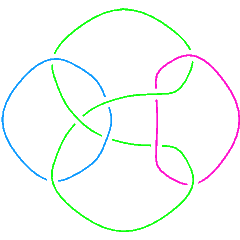 L9n27 |
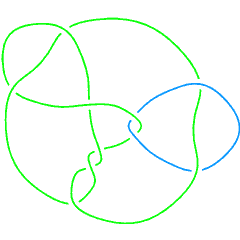 L10n32 |
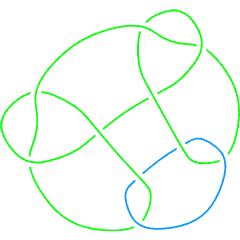 L10n36 |
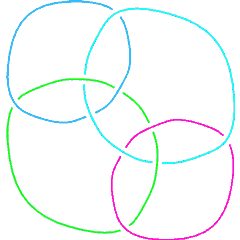 L10n107 |
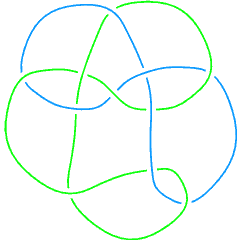 L11n244 |
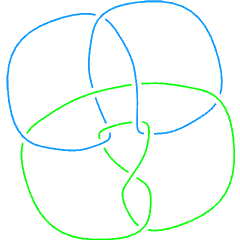 L11n247 |
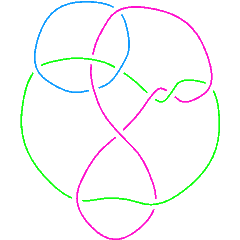 L11n334 |
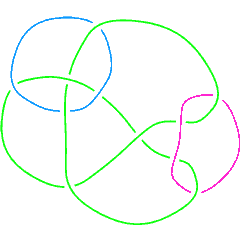 L11n381 |
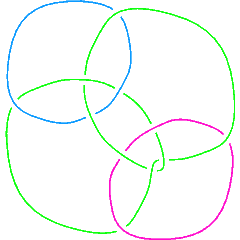 L11n396 |
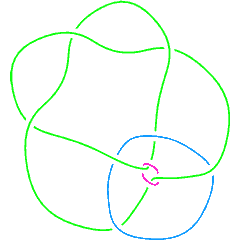 L11n404 |
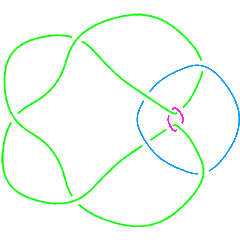 L11n406 |
Dror doesn't understand the multivariable Alexander polynomial well enough to give simple topological reasons for the vanishing of the said polynomial for these knots. (Though see the Talk Page).
Detecting a Link Using the Multivariable Alexander Polynomial
On May 1, 2007 AnonMoos asked Dror if he could identify the link in the figure on the right. So Dror typed:
In[7]:=
|
mva = MultivariableAlexander[L = PD[
X[1, 16, 2, 17], X[3, 15, 4, 14], X[5, 8, 6, 9],
X[7, 21, 8, 20], X[9, 22, 10, 13], X[11, 2, 12, 3],
X[13, 18, 14, 19], X[15, 12, 16, 1], X[17, 11, 18, 10],
X[19, 4, 20, 5], X[21, 7, 22, 6]
]][t]
|
Out[7]=
|
2
-(((-1 + t[1]) (-1 + t[2]) (1 - 2 t[1] + t[1] - 2 t[2] + 2 t[1] t[2] -
2 2 2 2 2
2 t[1] t[2] + t[2] - 2 t[1] t[2] + t[1] t[2] )) /
3/2 3/2
(t[1] t[2] ))
|
We don't know whether our mystery link appears in the link table as is, or as a mirror, or with its two components switched. Hence we let AllPossibilities contain the multivariable Alexander polynomials of all those possibilities:
In[8]:=
|
AllPossibilities = Union[Flatten[
{mva, -mva} /. {{}, {t[1] -> t[2], t[2] -> t[1]}}
]]
|
Out[8]=
|
2
{-(((-1 + t[1]) (-1 + t[2]) (1 - 2 t[1] + t[1] - 2 t[2] +
2 2 2 2 2
2 t[1] t[2] - 2 t[1] t[2] + t[2] - 2 t[1] t[2] + t[1] t[2]
3/2 3/2
)) / (t[1] t[2] )),
2
((-1 + t[1]) (-1 + t[2]) (1 - 2 t[1] + t[1] - 2 t[2] + 2 t[1] t[2] -
2 2 2 2 2
2 t[1] t[2] + t[2] - 2 t[1] t[2] + t[1] t[2] )) /
3/2 3/2
(t[1] t[2] )}
|
Finally, let us locate our link in the link table:
In[9]:=
|
Select[
AllLinks[],
MemberQ[AllPossibilities, MultivariableAlexander[#][t]] &
]
|
Out[9]=
|
{Link[11, Alternating, 289]}
|
And just to be sure,
In[10]:=
|
{Jones[L][q], Jones[Link[11, Alternating, 289]][q]}
|
Out[10]=
|
-(17/2) 4 8 12 16 18 17 15
{q - ----- + ----- - ----- + ---- - ---- + ---- - ---- +
15/2 13/2 11/2 9/2 7/2 5/2 3/2
q q q q q q q
10 3/2 5/2
------- - 7 Sqrt[q] + 3 q - q ,
Sqrt[q]
-(5/2) 3 7 3/2 5/2
-q + ---- - ------- + 10 Sqrt[q] - 15 q + 17 q -
3/2 Sqrt[q]
q
7/2 9/2 11/2 13/2 15/2 17/2
18 q + 16 q - 12 q + 8 q - 4 q + q }
|
Thus the mystery link is the mirror image of L11a289.

